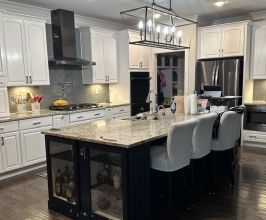Why does bright & white paint take so many coats to achieve coverage?
The opacity of a paint is the ability to "hide" the surface underneath.
Paints that have more hiding capacity are made with a "white" base which contains a larger combination of calcium carbonate and titanium dioxide. The calcium carbonate acts as a spacer to spread out the titanium dioxide, the most common ingredient used in paints to increase "hiding" properties.
Extra deep and extra bright colors have lower opacity because they start out in a "clear" base which contains only calcium carbonate. Very little titanium dioxide is added to a bright paint formula to help keep these colors vibrant, as with General Finishes Holiday Red or Klein Blue. Additionally, bright pigments have smaller particles which lowers opacity.
Neutral paint colors (light grays, browns, dark blues, dark greens, dark reds, etc.) contain a primary color(s) and a good amount of titanium dioxide, which provides excellent hide and requires fewer coats.
For example, if one coat of gray paint is put over a white surface, the outcome looks fairly gray. However, one coat of bright red paint over a white surface will leave a fair amount of white on the surface.
The opacity of paint (the ability to hide the surface underneath) has nothing to do with the viscosity (thickness of the paint).
The key is to learn the colors that are the most extreme among your favorite manufacturers and use them accordingly. This will help you plan time allotments for your project and your pricing.
Tip to improve coverage to reduce the number of coats using GF paints:
- Lay down a primer coat of a similar, high opacity paint first. For example, use Seagull Gray under Snow White; Buttermilk Yellow under Sunglow; Brick Red under Holiday Red; or Coastal Blue under Klein Blue.
- Use the correct applicator. For hand applications, a foam brush provides more coverage than a bristle brush.
- Always use a primer with light colors. This is especially true when painting over an existing dark finish.
- To achieve a bright white finish, use a combination of products from General Finishes paint system. For example, put down 2 coats of Stain Blocking Primer followed by two coats of Snow White Milk Paint or Brushable White enamel, or 2 coats of White Under Coat, followed by two coats of White Poly. All of our pigmented finishes are self-sealing and do not require a primer. Note: do not use a topcoat over white paint as it may cause yellowing.
This list below ranks the opacity of General Finishes Milk Paint colors. This contrast ratio testing was done on a sealed substrate with an 8 mil draw.
Milk Paint Color | Contrast Ratio |
|---|---|
Alabaster | 97.80 |
Antique White | 99.50 |
Ballet Pink | 99.99 |
Basil | 100.02 |
Blue Moon | 100.06 |
China Blue | 100.20 |
Coastal Blue | 97.60 |
Coral Crush | 98.20 |
Dark Chocolate | 100.15 |
Driftwood | 100.05 |
Emerald | 99.65 |
Empire Gray | 100.10 |
Gulf Stream Blue | 100.10 |
Halcyon Blue | 100.25 |
Harvest Yellow | 98.20 |
Holiday Red | 85.20 |
Keywest Blue | 100.10 |
Klein Blue | 83.00 |
Lamp Black | 99.95 |
Linen | 100.10 |
Millstone | 100.15 |
Patina Green | 100.10 |
Perfect Gray | 100.15 |
Persian Blue | 100.05 |
Persimmon | 98.10 |
Queenstown Gray | 100.50 |
Reverent Gray | 100.05 |
Seagull Gray | 100.30 |
Snow White | 97.75 |
Sunglow | 88.70 |
Tuscan Red | 98.60 |
Twilight | 100.10 |
Westminster Green | 99.99 |

 Enduro Water-Based Conversion Varnish
Enduro Water-Based Conversion Varnish
 Enduro Water Based Stain Blocker Primer
Enduro Water Based Stain Blocker Primer
 Enduro Water-Based Tintable 2K White Poly
Enduro Water-Based Tintable 2K White Poly
 Enduro Water-Based Pro Series White Polyurethane
Enduro Water-Based Pro Series White Polyurethane
 Hard Wax Oil & Hardener
Hard Wax Oil & Hardener
 Gel Stains
Gel Stains
 Pro Image Flooring Topcoat
Pro Image Flooring Topcoat
 Jen Poly Brushes
Jen Poly Brushes
 Stir Stix
Stir Stix
 Ultraflex Softback Sanding Sponge
Ultraflex Softback Sanding Sponge

